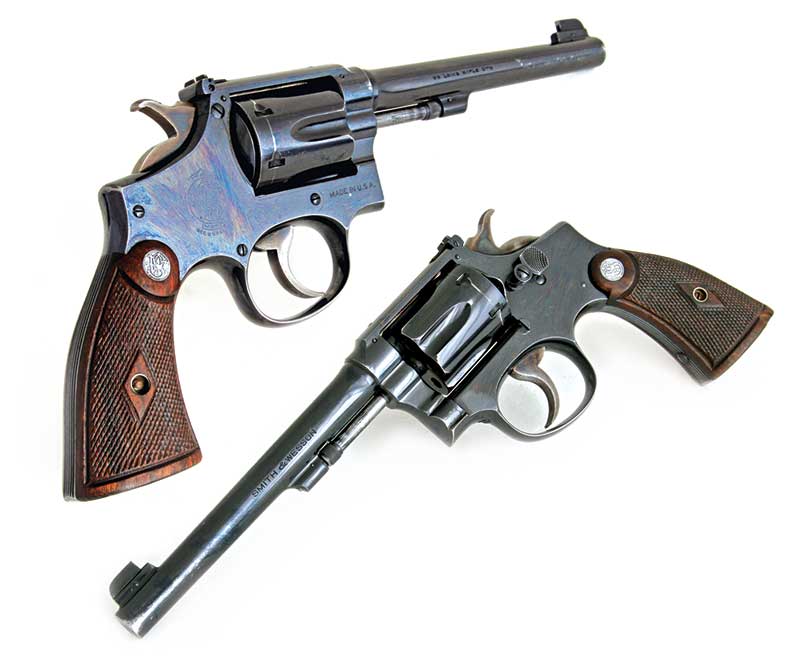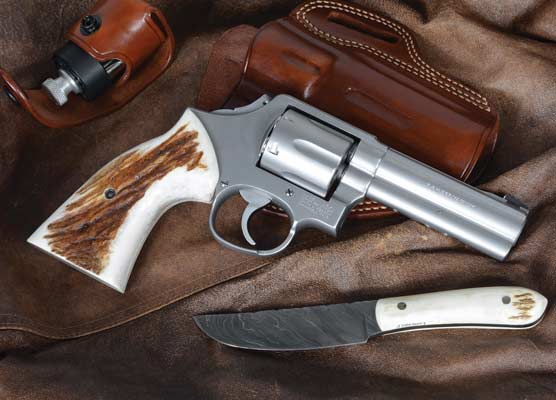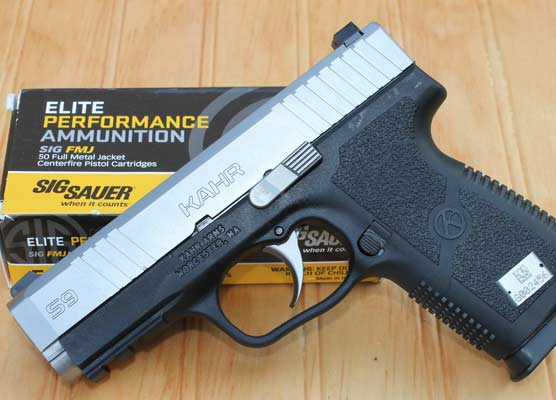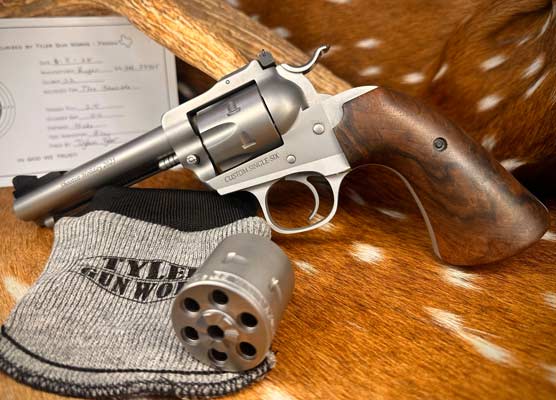S&W's K22
Still Timeless

Left: This K22 Target Model was made in 1937 and weighs 35½ ounces because competition
shooters began asking for a bit more weight for a steadier hold. Right: Looking like a twin to
its .38 Special brother, the K22 soon made a name for itself among target shooters and
outdoorsmen of all kinds. It was a near perfect trail gun.
In the early decades of the 20th century, .22 revolvers were mostly made on small frames — “small cartridge, small gun” seemed to be the rule. Target shooters wanted bigger and heavier revolvers, similar to their target .38 models. The new .22 models from Colt and S&W would prove to be very popular.
S&W had been offering .38 Special target revolvers on the medium K-frame for many years. A similar revolver in .22 cal. was a logical development. By late 1930 production was underway, with the first completed revolver presented to Douglas B. Wesson on January 3, 1931. The new model was called, oddly enough, the K22 Target Model. When the last revolver of the series was made on December 28, 1939 a total of 17,117 had been made.
Perhaps S&W was also getting requests from hunters and campers. Maybe they were concerned the competition market might not be big enough, or they may have been impressed with the success of Colt’s .22 auto pistol, “The Woodsman.” At any rate S&W touted the K22 as the “Outdoorsman’s” revolver. Revolver fans adopted the term.
Charles Call, a well-known competitive shooter, had developed a front sight with a round bead insert. The first 500 or so K22s feature this “Call bead” made of gold. Some sources say the bead was brass; I’ve never located an example, and if I did the owner would likely not let me pry the bead out to check. At any rate S&W soon changed to a silver-colored bead which appears to be of stainless steel.
The adjustable rear sight was beautifully fitted into the topstrap. Evidently polishing was done after the sight was fitted, as the fit is so close it’s hard to feel where the parts join. Single action pull was carefully tuned to a nominal three pounds. The revolver shown here has an outstanding, crisp 2.5-pound, single-action pull, and a very smooth 9-pound, double-action pull.
Craftsmanship
Introducing new target revolvers just as the Great Depression was taking hold was bad luck for S&W, good luck for those who could afford them (and for collectors in later years). Good luck because, with sales at a slow pace, there was no pressure to take shortcuts or rush production. Workers quite naturally wanted to keep their jobs; S&W naturally didn’t want to lose these highly trained and skilled workers.
S&W (along with most other firearms manufacturers) didn’t make a lot of guns during the 1930s, but those manufactured were very well made indeed. Lockwork components were carefully selected and fitted to provide virtually flawless operation. The walnut stocks were installed before metal polishing, then numbered to the gun so they could be reinstalled after the metal parts had been blued.
Metal polishing was beautifully done by experts who were as much artists as craftsmen. Around 1944 Bob Brownell (founder of Brownells) interviewed David Murray of S&W. He quotes Murray, “Here at the factory we estimate it takes about 15 years to make a really good polisher, and until he is good, he is incapable of handling the more difficult operations no matter how hard he tries …” (Gunsmith Kinks, 1969, F.R. Brownell).
Relatively cheap, highly skilled labor and tough economic times resulted, for a brief period, in custom quality at production prices. It’s a combination of circumstance we’re unlikely to see again (and most of us wouldn’t want to see again).
An Outdoor Success
Target shooters wanted a “short action” so the revolver could be cocked without altering the shooter’s grip, and a more precise adjustable sight. S&W introduced these changes in the short-lived (and very collectible) Second Model K22, with production ending when the US entered WWII.
After the war, under the leadership of C.R. Hellstrom, S&W spared no expense to build the perfect target revolver. A barrel rib was added, its width calculated so the .22., .32 and .38 cal. models all weighed exactly 38½ ounces.
Alas, the reign of target .22 revolvers was a short one. Competitors liked the idea of a pistol which cocked itself, leaving more time to refine sight picture in timed and rapid fire. Varous semiautos, the Colt Match Target, the High Standards and eventually S&W’s own Model 41 came to dominate bull’s-eye competition.
The K22s great success was with campers, hunters, plinkers, anglers. Whoever at S&W came up with the “Outdoorsman” label nailed it. In various forms the K22 has been in production continuously since 1930. Currently available is the Model 617 in stainless steel with 10-shot cylinder, and the Classic K22 in blued carbon steel with 6-shot cylinder.
I’ve owned K22s from every era and never owned one which wasn’t a good gun. S&W came up with a winner when they combined their K-frame with the .22 rimfire cartridge.

Get More Revolver Content Every Week!
Sign up for the Wheelgun Wednesday newsletter here:





